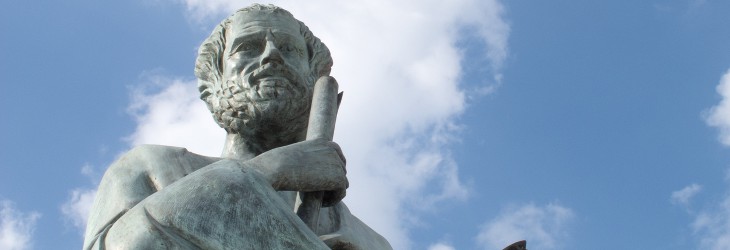The term “rhetoric” has a public relations problem. Today, many people often pair their conception of rhetoric to the toxicity of modern politics. This pairing is certainly warranted, as contemporary political partisanship seems to engage rhetoric’s negative potential – the baseless ad hominin attacks, the superfluous style, the over-the-top hyperbole. In another sense, however, rhetoric’s public relations problem is rooted in the void created in the absence of understanding. Rhetoric extends far beyond the political sphere—indeed, it is present in almost every aspect of our lives. Wherever there is meaning being conveyed between two or more parties, there is rhetoric at play. It is therefore important for people to understand rhetoric, its abilities, and its limitations, and the role it has played in the formation of human relationships from the interpersonal to the international level.
People’s lack of understanding of the omnipresence and importance of rhetoric both in our history and in modern life creates a paradox wherein we simultaneously lament its use in some contexts and celebrate its use in others. The paradox continues in our employment of the term – we know what rhetoric is when we see it, but struggle to define it without clear examples. Fortunately, the academic study of rhetoric provides us with a wealth of information, helping us to begin to unpack rhetoric’s role in human communication.
Defining Rhetoric
Several dozen definitions of rhetoric exist within Communication Studies today. Some scholars adhere to a more traditional definition, placing language and discourse at the center of their definitions, while others continue to adapt their definitions to fit our modern and multimodal world today.
In the discursive realm, Lloyd Bitzer (1968) said that “rhetoric is a mode of altering reality, not by the direct application of energy to objects, but by the creation of discourse which changes reality through the mediation of thought and action.” Kenneth Burke once remarked, “the basic function of rhetoric [is] the use of words by human agents to form attitudes or to induce actions in other human agents.” More simply put, rhetoric can be viewed as the use of language in all its forms (verbal, visual, gestural, etc.) to convey meaning, and to therefore persuade others of certain ideas, modes of action, or realities.
Recognizing that symbols extend beyond the realm of the discursive, other scholars extended (or at least opened up the possibility to extend) the definition of rhetoric to include visual and other nondiscursive symbols. For example, Sonja K. Foss (2017) defined rhetoric as “the human use of symbols to communicate,” arguing that in addition to the written and spoken word, rhetoric “includes nondiscursive or nonverbal symbols” like (but not limited to) “television programs, films and videos, video games, art, architecture,” and advertisements.
In short, to study rhetoric is to study the ways humans wield symbols for persuasive, political, and often, oppressive ends. Graduate seminars in rhetorical theory and criticism will certainly illuminate the definitional evolution of rhetoric and examine the ongoing discussions regarding rhetoric’s place within and outside of academia.
A (Brief) History of Rhetoric
Before turning to several theories and methodologies common in Rhetorical Studies today, it is important to, albeit briefly, trace the history of rhetoric. By and large, the history of rhetoric can be broken down (roughly) into five eras: Classical, Medieval, Renaissance, Enlightenment, and Modern. Some scholars also acknowledge a sixth era that encompasses our current time, which they define as “Postmodern” or the “new rhetorics.”
Many scholars often place the study of rhetoric as beginning with the Ancient Greeks, inaugurating the Classical era of rhetoric. Intellectuals spanning several generations in Ancient Greece debated the purpose and place of persuasion in society, and Aristotle eventually offered his definition of rhetoric to help understand persuasion, saying that rhetoric is discovering “the available means of persuasion.” Although studied by an assortment of other academic disciplines, scholars of rhetoric consider Aristotle to be a founding, if not the founding member of Rhetorical Studies.
In each subsequent time period, the study of rhetoric evolved, reflecting the social and cultural fluxions of the era while also seeking to expand upon previous scholarship. Medieval rhetorical scholars often examined or wrote from a Christian perspective, while Enlightenment rhetoric often dealt with the emergence of political thought that challenged existing power structures like monarchical rule. The evolution of rhetoric during these time periods, and the exclusive nature of certain communities’ definition of rhetoric, reflects the fact discussed earlier that rhetoric is a way of creating and conveying meaning—and therefore of shaping people’s understanding of reality. Perhaps more than most academic disciplines, there is a deeply entrenched Western bias within Rhetorical Studies, resulting in the silencing of contributions from the other parts of the world. Indeed, the aforementioned classified periods of rhetorical history are inherently Western and, when taught, often fail to mention other rhetorical traditions.
Within the last century and a half, the gradual turn to neoclassical and neo-Aristotelian critique in Rhetorical Studies helped propel scholars of speech to break away from English and, to an extent, History. In 1925, Herbert Wichelns published “The Literary Criticism of Oratory” and offered “a rationale for speech communication as a separate discipline” and a blueprint on “how to evaluate public speeches methodically” (Burgchardt, 2010).
In 1947, Ernest Wrage expanded Wichelns’ propositions, arguing in “Public Address: A Study in Social and Intellectual History” that rhetorical criticism “can make important contributions to social and intellectual history” and, often times, the “ideas, values, and beliefs of a culture are expressed in speeches” (Burgchardt, 2010). In addition to the work of several other scholars, Wichelns and Wrage’s scholarship helped legitimize Communication as its own, distinct academic discipline and provided the intellectual foundation for future scholars examining public address.
Topics in Rhetorical Criticism
Within Rhetorical Studies, there are several guiding theories and concepts scrutinized and employed by scholars. While most graduate seminars will undoubtedly provide a survey of these theories, many find that in order to better understand rhetoric, engaging in rhetorical criticism is oftentimes the best route.
The turn to the social sciences within Communication Studies in the last six decades requires equal consideration of one’s research methods and overarching scholarly methodology. In other words, one’s method of analysis – the tool one uses to answer a research question/argue a thesis – and one’s research methodology – a general justification to approaching research – are more important than ever. This discussion is certainly important and worthwhile. Below are examples of methods and methodologies at work within rhetorical criticism in an effort to provide an overview of the discipline:
Critical Rhetoric: Often referred to as “critical/cultural” studies, scholars that engage in critical rhetoric are concerned with and identify the “multiple, competing realities” at work in the “construction of identity and how power is assigned and exercised in society” (Burgchardt, 2010). In other words, critical rhetoric seeks to challenge the deeply entrenched structures of power at work in our world by focusing on “issues of race, ethnicity, class, gender, sexuality, and material conditions” and bringing to the fore ways in which to best enact change (Burgchardt, 2010).
“In practice,” Raymie Mckerrow (1989) wrote, “a critical rhetoric seeks to unmask or demystify the discourse of power” by “demonstrating the silent and often non-deliberate ways in which rhetoric conceals as much as it reveals.” Given its overarching goals, critical rhetoric does not employ a particular method of analysis, nor does it subscribe to one way of thinking. Rather, critical rhetoric scholars utilize whatever scholarly means are available to help reveal how power is communicated within a society.
In accordance with its purview, critical rhetoric “analyzes cultural fragments or artifacts such as monuments, museums, commercial spaces, visual images, popular culture and everyday life practices” (Burgchardt, 2010). For example, in their seminal essay on the concept of “whiteness,” Thomas Nakayama and Robert Krizek (1995) examined the “everydayness of whiteness,” or its presence in popular culture, visual images, and pedestrian discourse, and sought to bring to the fore the ways in which whiteness discursively operates in society.
Narrative Criticism: Human beings are a storytelling species. As Walter Fisher (1984) argued, “narrative, whether written or oral, is a feature of human nature” that crosses both “time and culture.” With the narrative paradigm, Fisher (1984) offered rhetorical critics the means to examine the intricacies of a narrative, like its rationality, probability, and fidelity.
Narrative criticism can also help to highlight an ideology or a motive at work within a story. For example, William Lewis (1987) observed President Reagan’s use of narrative in “telling America’s story” and how he embedded elements of conservatism into his retelling of American history. In so doing, Lewis (1987) argued, Reagan perpetuated a mythic version of America and “use(d) storytelling to direct his policies, ground his explanations, and inspire his audiences.”
Metaphoric Criticism: Considered one of the four master tropes, the metaphor is, of course, a tool of comparison and association that is “omnipresent in speech” (Richards, 1965). Analyzing a text through a metaphoric lens enables the critic to see how a speaker uses metaphor as an argument, and can also reveal a speaker’s motivation and gain insight into “an audience’s social reality” (Burgchardt, 2010).
In his foundational essay, “Archetypal Metaphor in Rhetoric: The Light-Dark Family,” Michael Osborn (1967) posited that because some metaphors are so universal to the human experience they can labeled as an archetype, as they stand the test of time, cross cultures and space, and are grounded in experiences “inescapably salient in human consciousness.” Indeed, critics utilizing the metaphoric lens today can probe the ways values and ideology are at work in the metaphors we use.
For example, a rhetorical critic today might analyze media coverage of American political debates and the extensive use of metaphor in that coverage. Oftentimes, these debates are framed through racing, sports, and or martial metaphors – candidates “win” or “lose,” “attack” one another, “clash” over ideas, or “fumble.” Rhetorically analyzing these metaphors could further elucidate how politics is communicated in America today.
Genre Criticism: Like with music, film, and literature, genre in rhetoric is “composed of a constellation of recognizable forms bound together by an internal dynamic” (K. K. Campbell & Jamieson, 1978). In other words, if enough similarities and patterns exist in a selection of speeches or texts, it may classify as a genre.
Despite this oversimplification, genre criticism is tricky to get right. Indeed, to be successful, a critic must examine numerous speeches or texts “in order to draw conclusions about categories of rhetoric” (Burgchardt, 2010). Examples of rhetorical genres range from apologia (a speech defending oneself) to a eulogy, and from presidential inaugural addresses to speeches given at nominating conventions.
One of the more enduring examples of genre in presidential discourse is the use of war rhetoric. From Lincoln’s description of Union efforts in the American Civil War to President Bush’s various speeches regarding the War on Terror, there is a similarity that binds the discourse together. What does this similarity mean for the American presidency? What does it mean for future presidents? Conducting a genre analysis could shed light on presidential rhetorical strategies.
Gender Criticism: An offshoot of critical rhetoric, gender criticism seeks to unveil how gender is constructed, maintained, oppressed, and disciplined through communication in society. Put differently, gender criticism can reveal the power embedded in gendered discourses and performances.
Palczewski et al. (2017) argued that in order to “develop a critical gendered lens” and better understand gender and communication, a vocabulary consisting of “intersectionality,” “communication,” and “systemic violence” ought to be adopted. With these terms in mind, the critic can truly begin to uncover the interconnectedness of gender, identity, power, and communication.
Today’s gender scholars can trace their intellectual lineage to the feminist rhetorical critics of the 1970s. Then, like now, feminist scholars are focused on a vast array of phenomena, including “how language itself oppresses or marginalizes women,” and argue that “women have distinctive methods and channels of communication that are no less sophisticated” and impactful than the hegemonic, male-dominated discourse controlling the levers of power in society (Burgchardt, 2010).
Conducting a gender rhetorical criticism could reveal the ways that female political candidates are discussed in news media, or even how they are framed by their opponents in campaign advertisements and speeches. In so doing, the critic can bring to the fore the lingering and embedded sexism in a culture’s politics today and perhaps prescribe rhetorical remedies to combat future sexist language.
Rhetoric of Social Movements: This subdiscipline of rhetoric and communication investigates the forms of persuasion that social movements employ to inspire collective action, garner popular support, and act to change the political status quo. Some of the most important political rhetoric of the 20th century came from collective protests and the representatives of grassroots organizations. These movements, most famously the Civil Rights Movement and the popular opposition to the Vietnam War, struggled for political change using novel persuasive strategies that could not be accounted for by existing scholarship on political rhetoric.
Contemporary scholars of the rhetoric of social movements embrace the challenge of analyzing the tactics and forms of persuasion that marginalized and radical groups use to seek political change, including spoken oratory, embodied and visual forms of rhetoric, and the tactical use of media technologies.
Material Rhetoric: Material rhetoric is an area of emphasis in rhetoric criticism that argues that persuasive discourse and its sociopolitical effects should be understood as material in nature. For material rhetoricians, this usually involves one of two approaches, which are not necessarily mutually exclusive. The first approach deals in understanding rhetorical discourse and its persuasive impact as mediated by the material contexts in which they are produced and circulated. In other words, some material rhetoricians depart from a view of language and politics inspired by Marxism, where discourse attains its power and meaning from the sociopolitical context it supports and justifies. In this vein, some materialist rhetoricians are, above all, interested in studying the sociopolitical contexts that animate rhetoric and give it its political force.
On the other hand, other rhetoricians are interested in understanding the way in which rhetoric, as a set of symbolic, persuasive appeals, is itself material. This line of inquiry attends to the ways in which persuasive appeals travel through signifiers: words, statues, paintings, Facebook posts, etc. These vehicles for transmitting persuasive appeals are each unique, and have a salient impact on the rhetorical impacts of particular persuasive discourses. The second kind of materialist rhetoric is, therefore, committed to understanding the materiality of language, as well as the various nonlinguistic means through which persuasion occurs, such as the visual, embodied rhetoric of monuments and museums.
The Rhetoric of Public Memory: Public memory describes how cultures and societies perceive history as a collective. The rhetoric of public memory is interested in the different symbolic and persuasive processes that work to establish these collective perceptions, as well as the ways through which individual rhetors and political and social groups contest public understandings of the past. Perhaps most importantly, the rhetoric of public memory argues the past is never static, and cultural perceptions of the past rarely, if ever, conform to an “objective” account of history.
Instead, public memory is constructed and maintained through a wide variety of rhetoric practices: traditional oratory may represent the past in ways that emphasize certain events while covering over others, monuments may mourn or valorize historical tragedies or military victories, television programs and films may revise or rewrite what we know about history. The rhetoric of public memory is focused on understanding the mnemonic impact of different representations of the past. Public memory scholars explore how those in power use different symbolic and persuasive means to secure certain collective views of history, as well as how subversive voices challenge these collective perceptions of history. In our contemporary moment, where debates over the history of race in the United States are highly visible and Holocaust denial continues to pose a pressing international problem, public memory has become an absolutely critical subject of rhetorical scholarship.
Studying Rhetoric Today
Rhetoric’s enduring presence through the ages cemented its status as a critical tool in uncovering how power is wielded through discourse. Today, studying rhetoric is perhaps more important than ever as discourses of power continue to evolve and manifest insidiously in places once thought impossible. However, expanding the discussion of rhetoric beyond the political sphere, and seeing its capabilities and impact in our everyday lives, is crucial. Far from being a tool used only by the powerful to manipulate the powerless, rhetoric is in fact a medium that can be used by anyone, from elementary school children to doctors, parents, CEOs, teachers, and (of course) writers.
Furthering this are the numerous emerging fields within rhetoric that also help to confront any negative attitudes toward the term by attesting to the breadth, depth, and diversity within the field. These emerging fields within rhetoric include, but are not limited to: health communication, visual communication, diversity studies, and memory studies. Rhetoric, the process of making and conveying meaning, of crafting new realities and moving people to action or contemplation, is inherently a hopeful area of study and practice. It is not an exaggeration to say that, by seeking to understand the nature and power of rhetoric, we can help build a more empathetic and equitable society.
Sources and Additional Resources
To learn more about rhetorical studies, including research in rhetorical criticism, critical rhetoric, narrative criticism, and gender criticism, check out the following resources:
- Bitzer, L. F. (1968). The Rhetorical Situation. Philosophy & Rhetoric, 1(1), 1–14. Retrieved from https://www.jstor.org/stable/40236733
- Burgchardt, C. R. (2010). Readings in Rhetorical Criticism (Fourth Edition). Strata Pub.
- Campbell, K. K., & Jamieson, K. H. (1978). Form and Genre: Shaping Rhetorical Action.
- Cloud, Dana L. “The materiality of discourse as oxymoron: A challenge to critical rhetoric.” Western Journal of Communication (includes Communication Reports) 58, no. 3 (1994): 141-163.
- Dickinson, Greg, Carole Blair, and Brian L. Ott, eds. Places of Public Memory: The Rhetoric of Museums and Memorials. University of Alabama Press, 2010.
- Fisher, W. R. (1984). Narration as a Human Communication Paradigm: The Case of Public Moral Argument. Communication Monographs, 51(1), 1.
- Foss, S. K. (2017). Rhetorical Criticism: Exploration and Practice, Fifth Edition. Waveland Press.
- Greene, Ronald Walter. “Another Materialist Rhetoric.” Critical Studies in Media Communication 15, no. 1 (1998): 21-40.
- Lewis, W. F. (1987). Telling America’s Story: Narrative Form and the Reagan Presidency. Quarterly Journal of Speech, 73(3), 280.
- McGee, Michael Calvin. “Text, Context, and the Fragmentation of Contemporary culture.” Western Journal of Communication, Vol. 54, no. 3 (1990): 274-289
- Mckerrow, R. E. (1989). Critical rhetoric: Theory and praxis. Communication Monographs, 56(2), 91–111.
- Osborn, M. (1967). Archetypal Metaphor in Rhetoric: The Light-Dark Family. Quarterly Journal of Speech, 53(2), 115–126.
- Palczewski, C. H., DeFrancisco, V. P., & McGeough, D. D. (2017). Gender in Communication: A Critical Introduction. SAGE Publications.
- Richards, I. A. (1965). The philosophy of rhetoric. New York: Oxford University Press.
Topics in Rhetorical Studies

Critical Rhetoric
This article discusses the field of critical rhetoric and its importance in the examination and exposure of power dynamics in society. It also provides information on key scholars in the field who study how rhetoric connects to equality, politics, and cultural values.

Gender Criticism
This detailed article discusses the history and forms of gender criticism in rhetorical studies, and also explains the political, social, and cultural significance of this field of study.

Genre Criticism
This article provides an overview of genre criticism in rhetorical studies, and how it has evolved over the centuries. It also explains the influential work of scholars in this field of study.

Material Rhetoric
This article explores scholarly approaches to understanding persuasion as material. Explore how scholars have attempted to understand rhetorical discourse as a material thing, and, on the other hand, how material things, like monuments and roads, can be politically persuasive.

Metaphoric Criticism
This article explains how metaphors are widely used in human communication and understanding, and provides a background on the history and prominent scholarship of this field.

Narrative Criticism
This article covers narrative criticism and the role it plays in culture, politics, and relationships, while also providing examples of prominent scholarship in this field.

Rhetoric of Social Movements
This article examines the history and impact of social movement rhetorical research, and provides readers with a detailed overview of some of the latest research in the field that is being completed by eminent scholars of social justice and civil rights rhetoric.


